Influence of Thermal Environment on College Students’ Learning Performance in Hot Overhead Spaces in China
Abstract
:1. Introduction
2. Materials and Methods
2.1. Study Area and Weather Conditions
2.2. Measured Parameters and Instruments
2.3. Outdoor Thermal Comfort Index
2.4. Survey Questionnaire
2.5. Cognitive Test
2.6. Experimental Procedures
3. Results
3.1. Descriptive Statistics
3.2. Subjective Views of Factors Affecting Learning Performance
3.3. Symptoms of Fatigue
3.4. Thermal Response Analysis
3.4.1. Distribution of Thermal Sensation Vote
3.4.2. Thermal Satisfaction
3.4.3. Preference of Thermal Parameter
3.5. Correlation between MTSV Variation and Thermal Parameters
3.6. Thermal Stress Corresponding to Thermal Indices
3.7. Thermal Parameters and Thermal Acceptability
3.8. Differences in Learning Performance
3.9. Relationship between PET and Learning Performance
4. Discussion
4.1. Comparison of Thermal Comfort with Other Regions
4.2. Indoor Learning Performance
4.3. Suggestions for Renovation of Overhead Spaces
4.4. Limitations and Future Research
5. Conclusions
- Subjects would prioritize Ta and Va when choosing to study in the overhead; they were relatively insensitive to RH and Tmrt. Subjects were more likely to feel fatigued in thermal environments with higher Ta. Most subjects expressed the following: “My eyes are getting tired”.
- Subjects’ MTSV had no correlation with Ta, Va, RH, and Tmrt in Stage 1 and had a positive correlation with Ta and Tmrt in Stage 2. It was negatively correlated with RH and insignificantly correlated with Va in both stages. The neutral PET of the subjects was 25.5 °C, and the maximum acceptable PET was 30.2 °C.
- In neutral to slightly warm conditions, perception and short-term memory increased with PET by 2.5% and 1.1%, respectively; however, if the short-term memory test was more difficult, the relationship between the hot environment and learning performance was not significant, and when the environment was overheated, the learning performance declined as a whole, but the magnitude of the decline showed individual differences. In the attention-oriented test, learning performance decreased by 1% as PET increased from 30.4 °C to 36.8 °C, indicating that the thermal environment would have an effect on the attention of college students.
- As the temperature of the overhead floor changes daily, it is recommended that different types of studies be conducted at varying time periods. When the environment of the overhead floor is too hot, the attention of college students decreases, in which case it is recommended that students go indoors to study.
- Learning efficiency is affected by the thermal environment, and it is of great significance to make targeted improvements to the thermal environment of the elevated floor for the learning population. This should mainly be through the study of the perimeter of the overhead layer tree planting methods, tree species, ground materials, and appropriate height of the overhead layer.
Author Contributions
Funding
Data Availability Statement
Conflicts of Interest
References
- Kumar, S.; Tewari, P.; Mathur, S.; Mathur, J. Development of mathematical correlations for indoor temperature from field observations of the performance of high thermal mass buildings in India. Build. Environ. 2017, 122, 324–342. [Google Scholar] [CrossRef]
- Kang, S.X.; Ou, D.Y.; Mak, C.M. The impact of indoor environmental quality on work productivity in university open-plan research offices. Build. Environ. 2017, 124, 78–89. [Google Scholar] [CrossRef]
- Zhang, F.; Haddad, S.; Nakisa, B.; Rastgoo, M.N.; Candido, C.; Tjondronegoro, D.; de Dear, R. The effects of higher temperature setpoints during summer on office workers’ cognitive load and thermal comfort. Build. Environ. 2017, 123, 176–188. [Google Scholar] [CrossRef]
- Valancius, R.; Jurelionis, A. Influence of indoor air temperature variation on office work performance. J. Environ. Eng. Landsc. Manag. 2013, 21, 19–25. [Google Scholar] [CrossRef]
- Milton, D.K.; Glencross, P.M.; Walters, M.D. Risk of sick leave associated with outdoor air supply rate, humidification, and occupant complaints. Indoor Air-Int. J. Indoor Air Qual. Clim. 2000, 10, 212–221. [Google Scholar] [CrossRef] [PubMed]
- Tham, K.W. Indoor air quality and its effects on humans-A review of challenges and developments in the last 30 years. Energy Build. 2016, 130, 637–650. [Google Scholar] [CrossRef]
- Pérez-Lombard, L.; Ortiz, J.; Pout, C. A review on buildings energy consumption information. Energy Build. 2008, 40, 394–398. [Google Scholar] [CrossRef]
- Chua, K.J.; Chou, S.K.; Yang, W.M.; Yan, J. Achieving better energy-efficient air conditioning—A review of technologies and strategies. Appl. Energy 2013, 104, 87–104. [Google Scholar] [CrossRef]
- Chen, A.L.; Chang, V.W.C. Human health and thermal comfort of office workers in Singapore. Build. Environ. 2012, 58, 172–178. [Google Scholar] [CrossRef]
- D’Amato, M.; Molino, A.; Calabrese, G.; Cecchi, L.; Annesi-Maesano, I.; D’Amato, G. The impact of cold on the respiratory tract and its consequences to respiratory health. Clin. Transl. Allergy 2018, 8, 20. [Google Scholar] [CrossRef]
- Elgheznawy, D.; Eltarabily, S. The impact of sun sail-shading strategy on the thermal comfort in school courtyards. Build. Environ. 2021, 202, 108046. [Google Scholar] [CrossRef]
- Hwang, R.-L.; Lin, T.-P. Thermal comfort requirements for occupants of semi-outdoor and outdoor environments in hot-humid regions. Archit. Sci. Rev. 2007, 50, 357–364. [Google Scholar] [CrossRef]
- Sarbu, I.; Pacurar, C. Experimental and numerical research to assess indoor environment quality and schoolwork performance in university classrooms. Build. Environ. 2015, 93, 141–154. [Google Scholar] [CrossRef]
- Lan, L.; Tang, J.; Wargocki, P.; Wyon, D.P.; Lian, Z. Cognitive performance was reduced by higher air temperature even when thermal comfort was maintained over the 24–28 °C range. Indoor Air 2022, 32, e12916. [Google Scholar] [CrossRef] [PubMed]
- Wang, X.; Li, D.; Menassa, C.C.; Kamat, V.R. Investigating the effect of indoor thermal environment on occupants’ mental workload and task performance using electroencephalogram. Build. Environ. 2019, 158, 120–132. [Google Scholar] [CrossRef]
- Barbic, F.; Minonzio, M.; Cairo, B.; Shiffer, D.; Cerina, L.; Verzeletti, P.; Badilini, F.; Vaglio, M.; Porta, A.; Santambrogio, M.; et al. Effects of a cool classroom microclimate on cardiac autonomic control and cognitive performances in undergraduate students. Sci. Total Environ. 2022, 808, 152005. [Google Scholar] [CrossRef]
- Cho, H. The effects of summer heat on academic achievement: A cohort analysis. J. Environ. Econ. Manag. 2017, 83, 185–196. [Google Scholar] [CrossRef]
- Pradhan, S.; Jang, Y.; Chauhan, H. Investigating effects of indoor temperature and lighting on university students’ learning performance considering sensation, comfort, and physiological responses. Build. Environ. 2024, 253, 111346. [Google Scholar] [CrossRef]
- Gündogdu, B.; Nouri, A.S.; Afacan, Y.; Matzarakis, A. Investigating the impacts of shaded outdoor spaces on thermal adaptation and cognitive performance of university students in classroom environments. Int. J. Biometeorol. 2023, 67, 1941–1955. [Google Scholar] [CrossRef]
- Błażejczyk, K. UTCI—10 years of applications. Int. J. Biometeorol. 2021, 65, 1461–1462. [Google Scholar] [CrossRef]
- Zou, B.W.; Fan, C.L.; Li, J.J. Quantifying the Influence of Different Block Types on the Urban Heat Risk in High-Density Cities. Buildings 2024, 14, 2131. [Google Scholar] [CrossRef]
- Lau, S.S.Y.; Zhang, J.; Tan, Y.Q. A comparative study of thermal comfort in learning spaces using three different ventilation strategies on a tropical university campus. Build. Environ. 2019, 148, 579–599. [Google Scholar] [CrossRef]
- Wong, N.H.; Song, J.; Istiadji, A.D. A study of the effectiveness of mechanical ventilation systems of a hawker center in Singapore using CFD simulations. Build. Environ. 2006, 41, 726–733. [Google Scholar] [CrossRef]
- Acero, J.A.; Ruefenacht, L.A.; Koh, E.J.Y.; Tan, Y.S.; Norford, L.K. Measuring and comparing thermal comfort in outdoor and semi-outdoor spaces in tropical Singapore. Urban Clim. 2022, 42, 101122. [Google Scholar] [CrossRef]
- Kicherova, M.; Zyuban, E.; Muslimova, E. Non-Formal and Informal Learning: International Recognition Practices. Vopr. Obraz.-Educ. Stud. Mosc. 2020, 126–158. [Google Scholar] [CrossRef]
- Tao, Y.; Zhao, F.; Xue, M.; Jiang, B.; Lau, S.S.Y.; Zhang, L. Factors Influencing Seating Preferences in Semi-Outdoor Learning Spaces at Tropical Universities. Buildings 2023, 13, 982. [Google Scholar] [CrossRef]
- Deng, X.; Nie, W.; Li, X.; Wu, J.; Yin, Z.; Han, J.; Pan, H.; Lam, C.K.C. Influence of built environment on outdoor thermal comfort: A comparative study of new and old urban blocks in Guangzhou. Build. Environ. 2023, 234, 110133. [Google Scholar] [CrossRef]
- Mao, Y.; Zhu, Y.; Guo, Z.; Zheng, Z.; Fang, Z.; Chen, X. Experimental investigation of the effects of personal protective equipment on thermal comfort in hot environments. Build. Environ. 2022, 222, 109352. [Google Scholar] [CrossRef] [PubMed]
- Li, K.M.; Zhang, Y.F.; Zhao, L.H. Outdoor thermal comfort and activities in the urban residential community in a humid subtropical area of China. Energy Build. 2016, 133, 498–511. [Google Scholar] [CrossRef]
- Dell’Isola, M.; Frattolillo, A.; Palella, B.I.; Riccio, G. Influence of Measurement Uncertainties on the Thermal Environment Assessment. Int. J. Thermophys. 2012, 33, 1616–1632. [Google Scholar] [CrossRef]
- Meteorology, V.E. Methods for the human Biometeorological Evaluation of Climate and Air Quality for the Urban and Regional Planning at Regional Level; VDI: Berlin, Germany, 1998; Volume 3787. [Google Scholar]
- Höppe, P. The physiological equivalent temperature: A universal index for the biometeorological assessment of the thermal environment. Int. J. Biometeorol. 1999, 43, 71–75. [Google Scholar] [CrossRef] [PubMed]
- Gulyas, A.; Unger, J.; Matzarakis, A. Assessment of the microclimatic and human comfort conditions in a complex urban environment:: Modelling and measurements. Build. Environ. 2006, 41, 1713–1722. [Google Scholar] [CrossRef]
- Chen, L.; Ng, E. Outdoor thermal comfort and outdoor activities: A review of research in the past decade. Cities 2012, 29, 118–125. [Google Scholar] [CrossRef]
- Heng, S.L.; Chow, W.T.L. How ‘hot’ is too hot? Evaluating acceptable outdoor thermal comfort ranges in an equatorial urban park. Int. J. Biometeorol. 2019, 63, 801–816. [Google Scholar] [CrossRef] [PubMed]
- Cheung, P.K.; Jim, C.Y. Subjective outdoor thermal comfort and urban green space usage in humid-subtropical Hong Kong. Energy Build. 2018, 173, 150–162. [Google Scholar] [CrossRef]
- ANSI/ASHRAE, 55. Thermal Environmental Conditions for Human Occupancy; American Society of Heating: Norcross, GA, USA, 1992; Volume 5.
- ISO7730; Determination of the PMV and PPD Indices and Specification of the Conditions for Thermal Comfort. International Organisation for Standardisation: Geneva, Switzerland, 1994.
- Yoshitake, H. Occupational Fatigue-Approach from Subjective Symptom; The Institute for Science of Labor: Tokyo, Japan, 1973. (In Japanese) [Google Scholar]
- Tanabe, S.; Nishihara, N. Productivity and fatigue. Indoor Air 2004, 14, 126. [Google Scholar] [CrossRef] [PubMed]
- Zhang, X.; Wargocki, P.; Lian, Z.; Thyregod, C. Effects of exposure to carbon dioxide and bioeffluents on perceived air quality, self-assessed acute health symptoms, and cognitive performance. Indoor Air 2017, 27, 47–64. [Google Scholar] [CrossRef]
- Lan, L.; Lian, Z. Use of neurobehavioral tests to evaluate the effects of indoor environment quality on productivity. Build. Environ. 2009, 44, 2208–2217. [Google Scholar] [CrossRef]
- Liu, W.; Zhong, W.; Wargocki, P. Performance, acute health symptoms and physiological responses during exposure to high air temperature and carbon dioxide concentration. Build. Environ. 2017, 114, 96–105. [Google Scholar] [CrossRef]
- Lan, L.; Lian, Z.; Pan, L.; Ye, Q. Neurobehavioral approach for evaluation of office workers’ productivity: The effects of room temperature. Build. Environ. 2009, 44, 1578–1588. [Google Scholar] [CrossRef]
- Stroop, J.R. Studies of interference in serial verbal reactions. J. Exp. Psychol. 1935, 18, 643. [Google Scholar] [CrossRef]
- Leon-Dominguez, U.; Francisco Martin-Rodriguez, J.; Leon-Carrion, J. Executive n-back tasks for the neuropsychological assessment of working memory. Behav. Brain Res. 2015, 292, 167–173. [Google Scholar] [CrossRef] [PubMed]
- Lan, L. Mechanism and Evaluation of Indoor Environment on Personnel Work Efficiency. Master’s Thesis, Shanghai Jiao Tong University, Shanghai, China, 2010. [Google Scholar]
- Nishihara, N.; Xiong, J.; Kim, J.; Zhu, H.; de Dear, R. Effect of adaptive opportunity on cognitive performance in warm environments. Sci. Total Environ. 2022, 823, 153698. [Google Scholar] [CrossRef] [PubMed]
- Tian, X.; Fang, Z.; Liu, W. Decreased humidity improves cognitive performance at extreme high indoor temperature. Indoor Air 2021, 31, 608–627. [Google Scholar] [CrossRef] [PubMed]
- Fukawa, Y.; Watanabe, Y.; Ogawa, Y.; Hisayama, R.; Nomoto, A.; Nakano, J.; Nakagawa, J.; Tanabe, S.-i. Effects of various environmental grades on thermal comfort in semi-outdoor spaces. Jpn. Archit. Rev. 2023, 6, e12414. [Google Scholar] [CrossRef]
- Wang, W.; Ding, G.; Wang, Y.; Li, J. Field study on the effect of space type, exercise intensity, and wet bulb globe temperature on thermal responses of exercisers. Build. Environ. 2022, 225, 109555. [Google Scholar] [CrossRef]
- Zafarmandi, S.; Mahdavinejad, M.; Norford, L.; Matzarakis, A. Analyzing Thermal Comfort Sensations in Semi-Outdoor Space on a University Campus: On-Site Measurements in Tehran’s Hot and Cold Seasons. Atmosphere 2022, 13, 1034. [Google Scholar] [CrossRef]
- Xie, X.; Liao, H.; Wang, R.; Gou, Z. Thermal Comfort in the Overhead Public Space in Hot and Humid Climates: A Study in Shenzhen. Buildings 2022, 12, 1454. [Google Scholar] [CrossRef]
- Spagnolo, J.; de Dear, R. A field study of thermal comfort in outdoor and semi-outdoor environments in subtropical Sydney Australia. Build. Environ. 2003, 38, 721–738. [Google Scholar] [CrossRef]
- Othman, N.E.; Zaki, S.A.; Rijal, H.B.; Ahmad, N.H.; Razak, A.A. Field study of pedestrians’ comfort temperatures under outdoor and semi-outdoor conditions in Malaysian university campuses. Int. J. Biometeorol. 2021, 65, 453–477. [Google Scholar] [CrossRef]
- Zhao, Y.; Yang, J.; Fang, Z.; Zhang, X.; Guo, T.; Li, Y. Passive design strategies to improve student thermal comfort: A field study in semi-outdoor spaces of academic buildings in hot-humid areas. Urban Clim. 2024, 53, 101807. [Google Scholar] [CrossRef]
- Mihara, K.; Chen, S.; Hasama, T.; Tan, C.L.; Lee, J.K.W.; Wong, N.H. Environmental satisfaction, mood and cognitive performance in semi-outdoor space in the tropics. Build. Environ. 2022, 216, 109051. [Google Scholar] [CrossRef]
- Cen, C.; Cheng, S.; Wong, N.H. Effect of elevated air temperature and air velocity on thermal comfort and cognitive performance in the tropics. Build. Environ. 2023, 234, 110203. [Google Scholar] [CrossRef]
- Kawakubo, S.; Sugiuchi, M.; Arata, S. Office thermal environment that maximizes workers’ thermal comfort and productivity. Build. Environ. 2023, 233, 110092. [Google Scholar] [CrossRef]
- Yang, Y.; Hu, L.; Zhang, R.; Zhu, X.; Wang, M. Investigation of students? short-term memory performance and thermal sensation with heart rate variability under different environments in summer. Build. Environ. 2021, 195, 107765. [Google Scholar] [CrossRef]
- Xiong, L.; Huang, X.; Li, J.; Mao, P.; Wang, X.; Wang, R.; Tang, M. Impact of Indoor Physical Environment on Learning Efficiency in Different Types of Tasks: A 3 × 4 × 3 Full Factorial Design Analysis. Int. J. Environ. Res. Public Health 2018, 15, 1256. [Google Scholar] [CrossRef]
- Yang, J.; Zhao, Y.; Zou, Y.; Xia, D.; Lou, S.; Liu, W.; Ji, K. Effects of Tree Species and Layout on the Outdoor Thermal Environment of Squares in Hot-Humid Areas of China. Buildings 2022, 12, 1867. [Google Scholar] [CrossRef]
- Yang, J.; Zhao, Y.; Guo, T.; Luo, X.; Ji, K.; Zhou, M.; Wan, F. The impact of tree species and planting location on outdoor thermal comfort of a semi-outdoor space. Int. J. Biometeorol. 2023, 67, 1689–1701. [Google Scholar] [CrossRef]
- Xie, X.; Sun, Z.; Zhu, X.; Zhao, S.; Wang, Z.; Zhai, Y. Influence of misting system on the thermal environment and thermal comfort of seated people in semi-outdoor space in Xi’an, China. Front. Archit. Res. 2024, 13, 668–681. [Google Scholar] [CrossRef]
- te Kulve, M.; Schlangen, L.; Lichtenbelt, W.v.M. Interactions between the perception of light and temperature. Indoor Air 2018, 28, 881–891. [Google Scholar] [CrossRef]
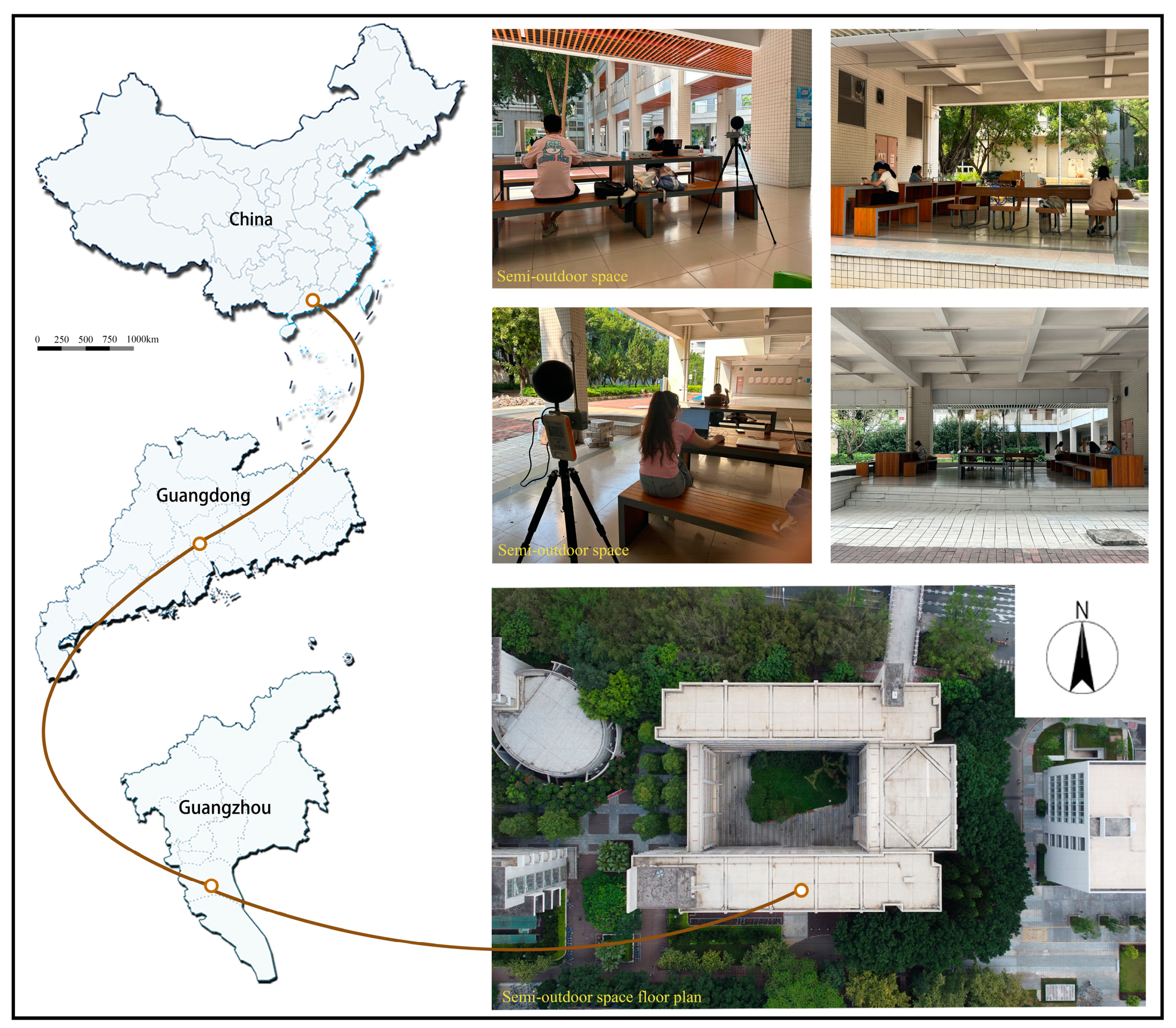
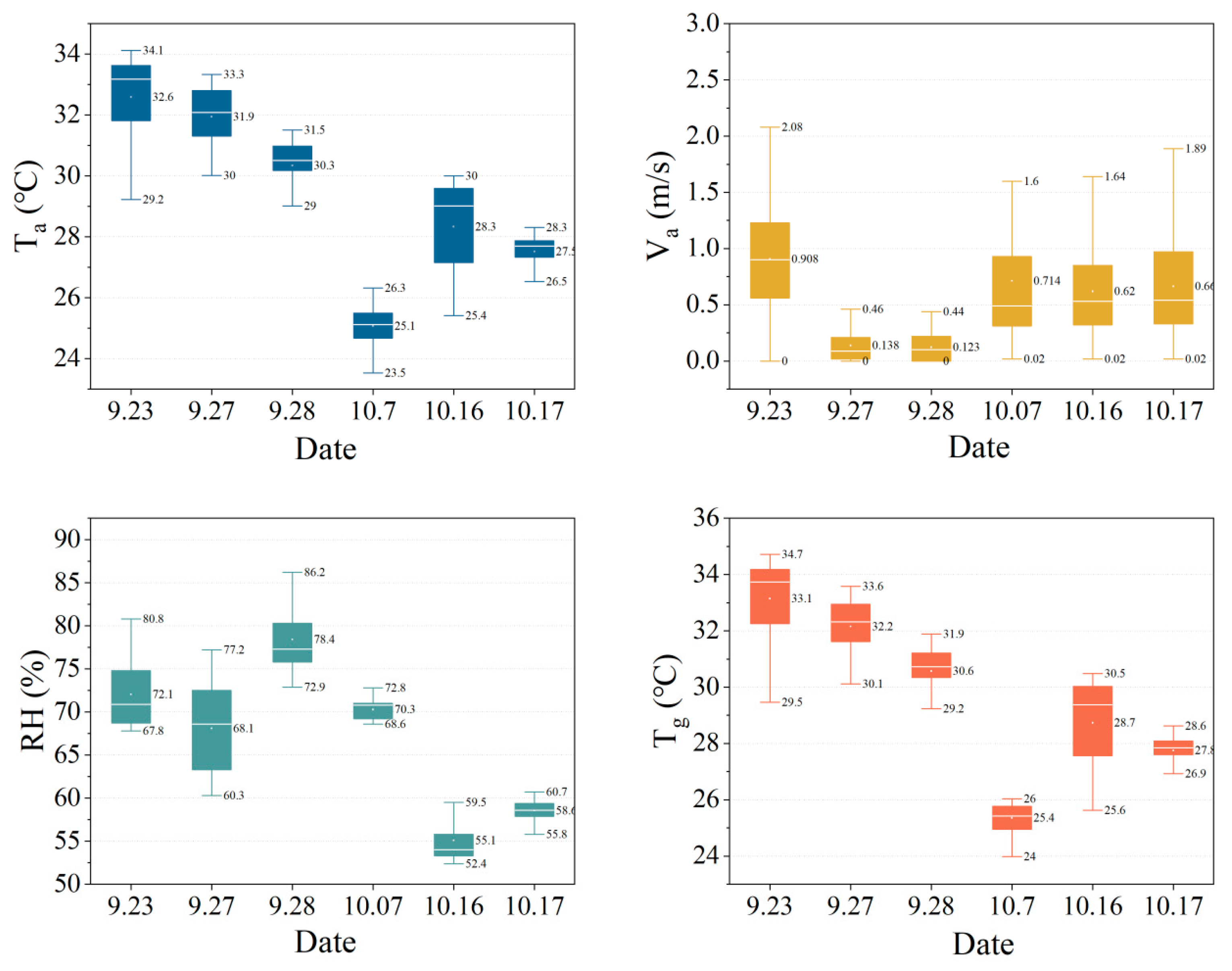
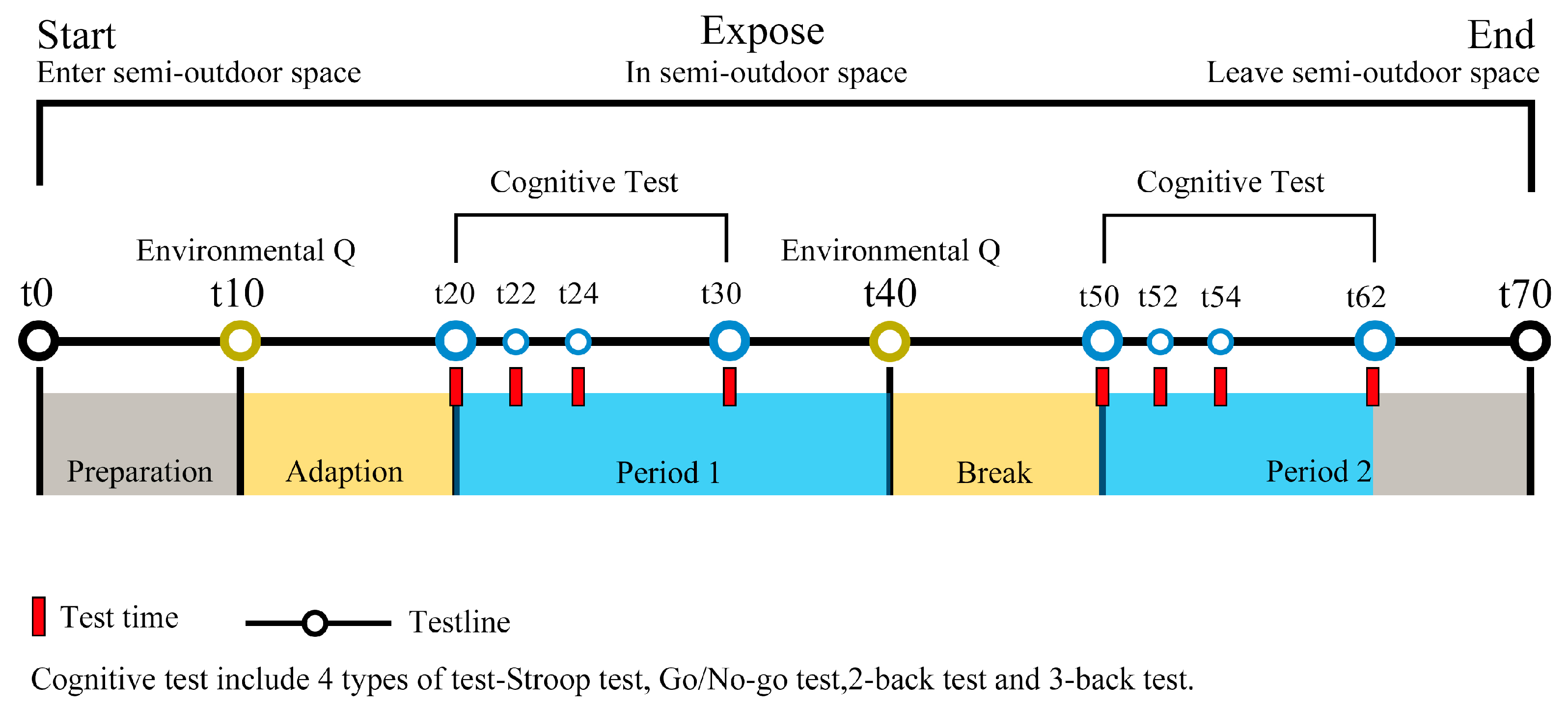
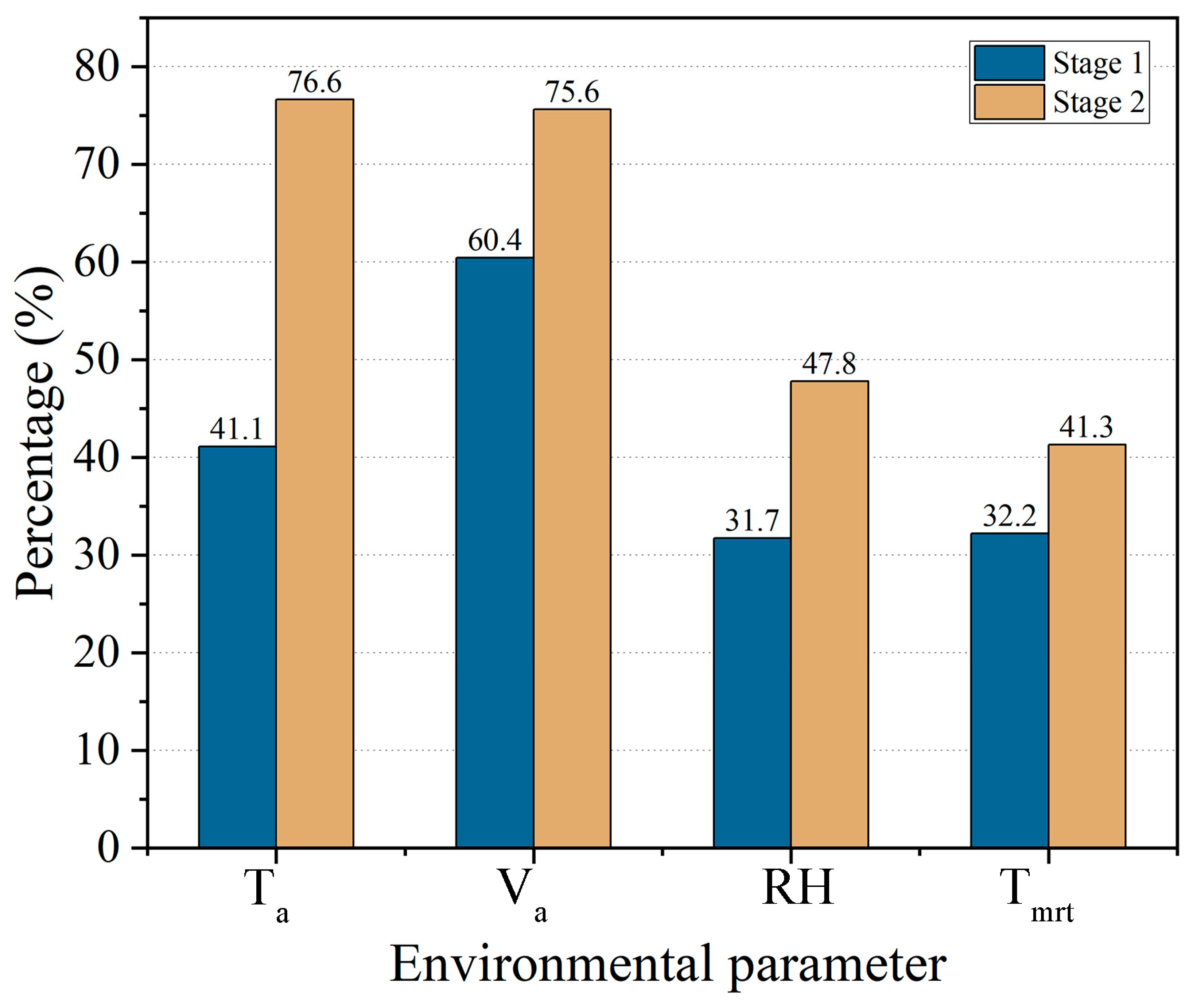
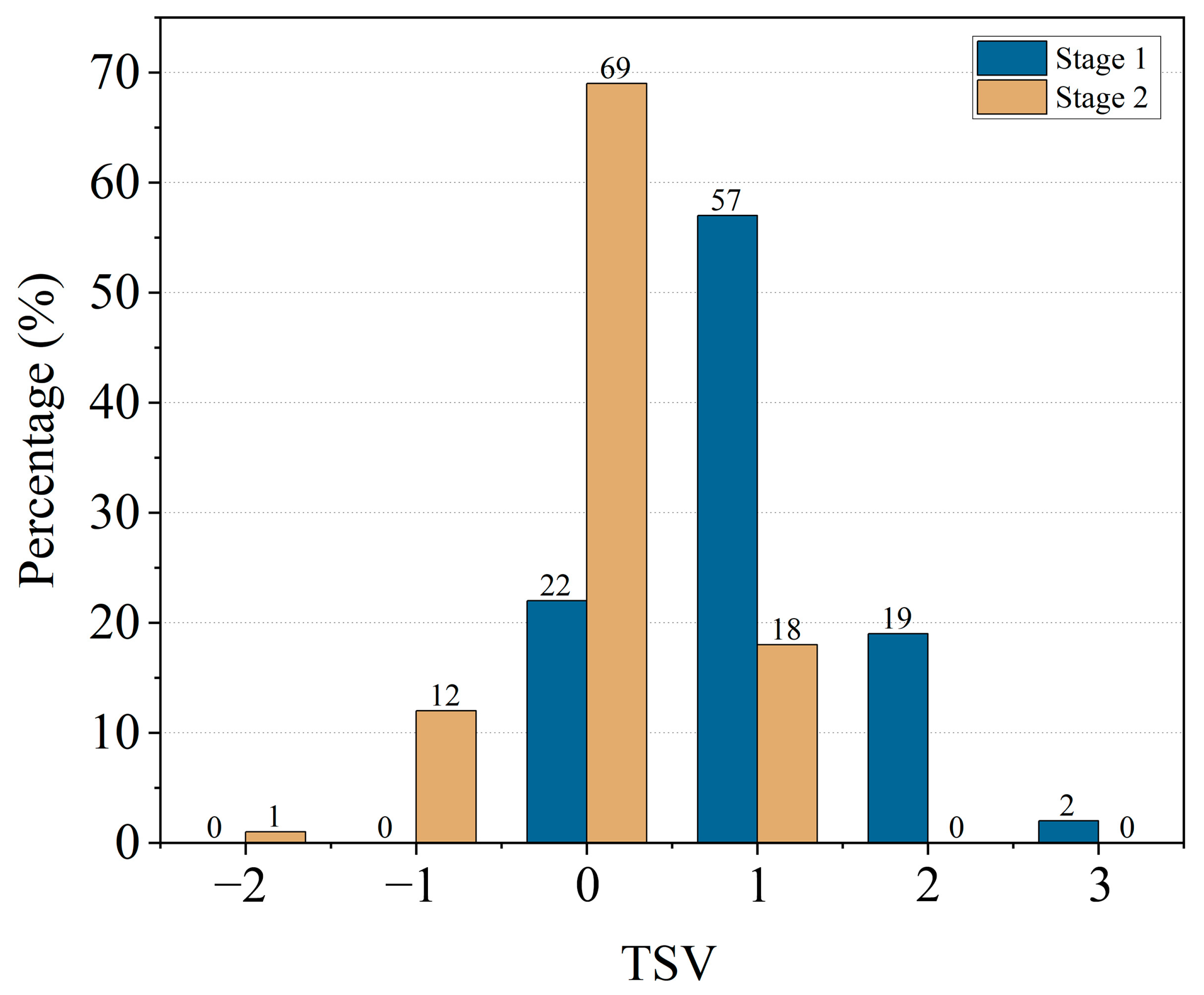

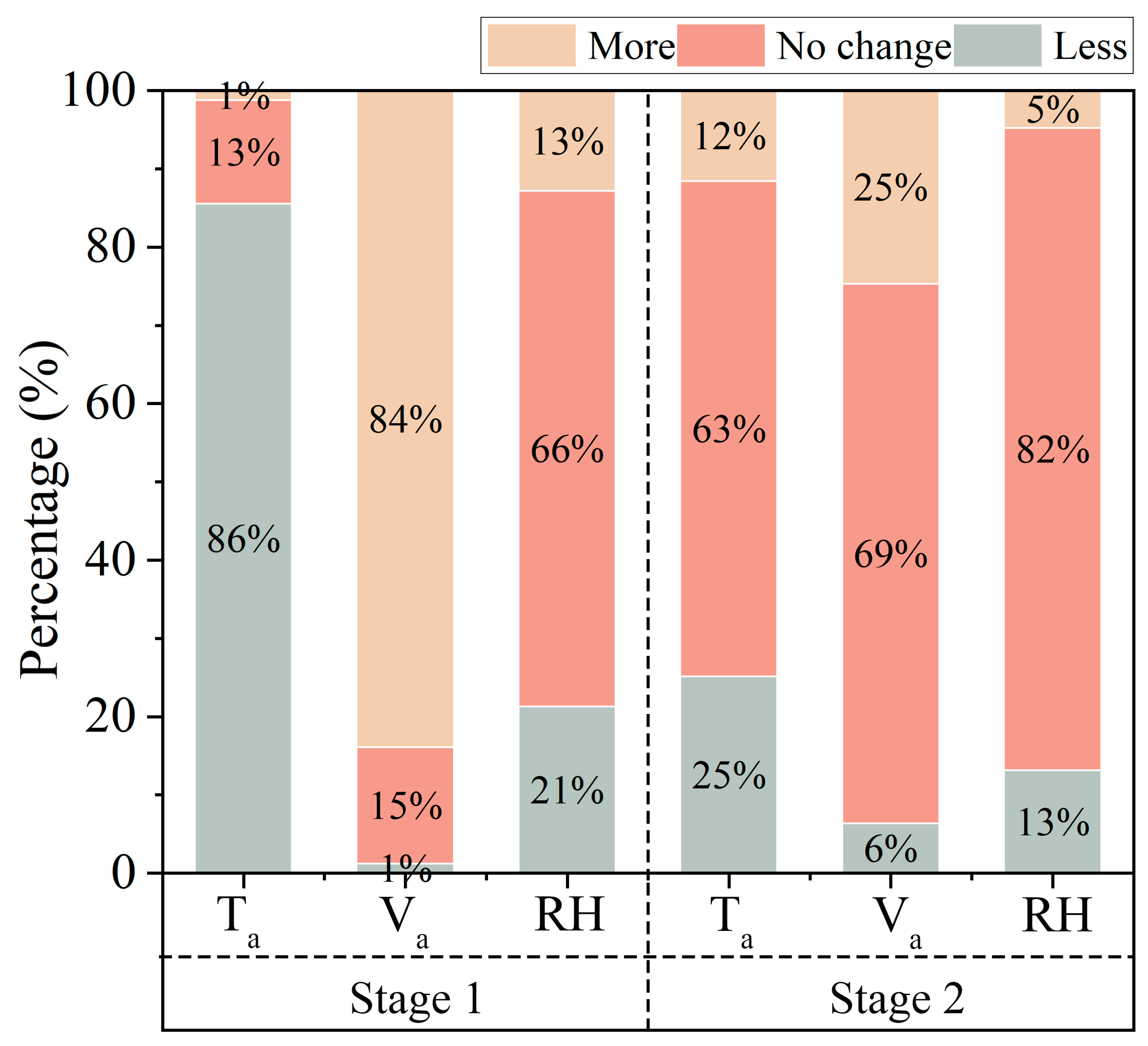
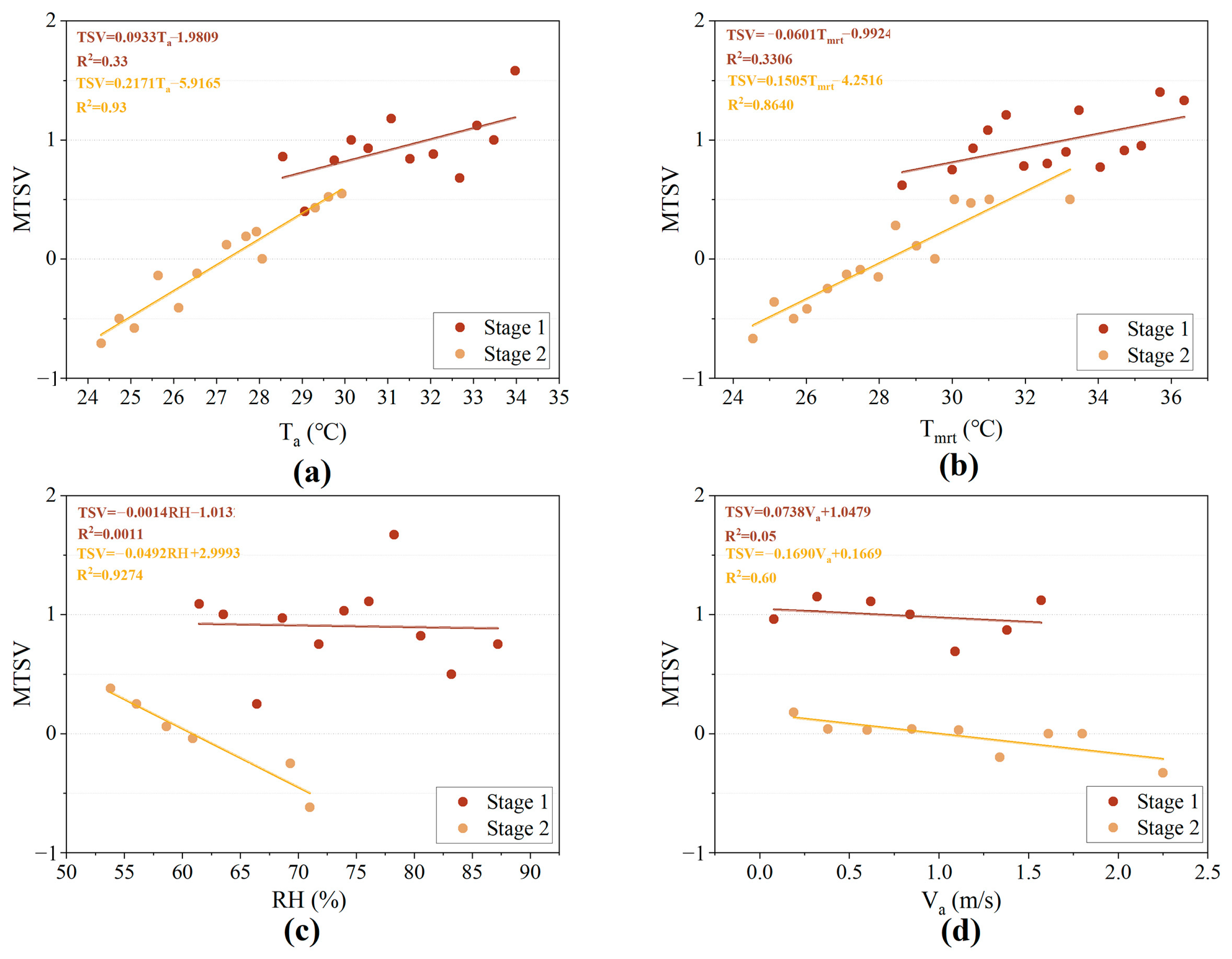
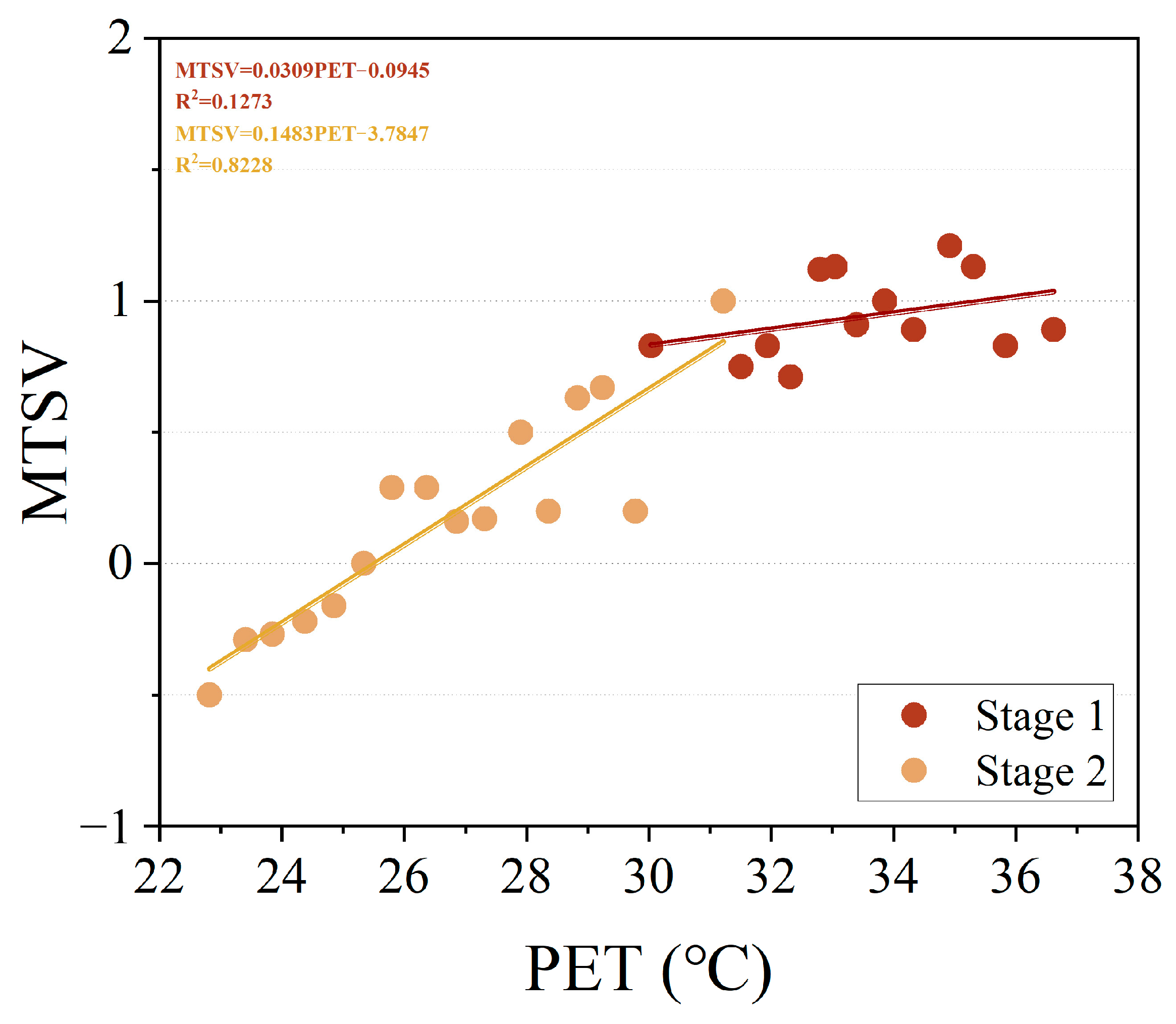

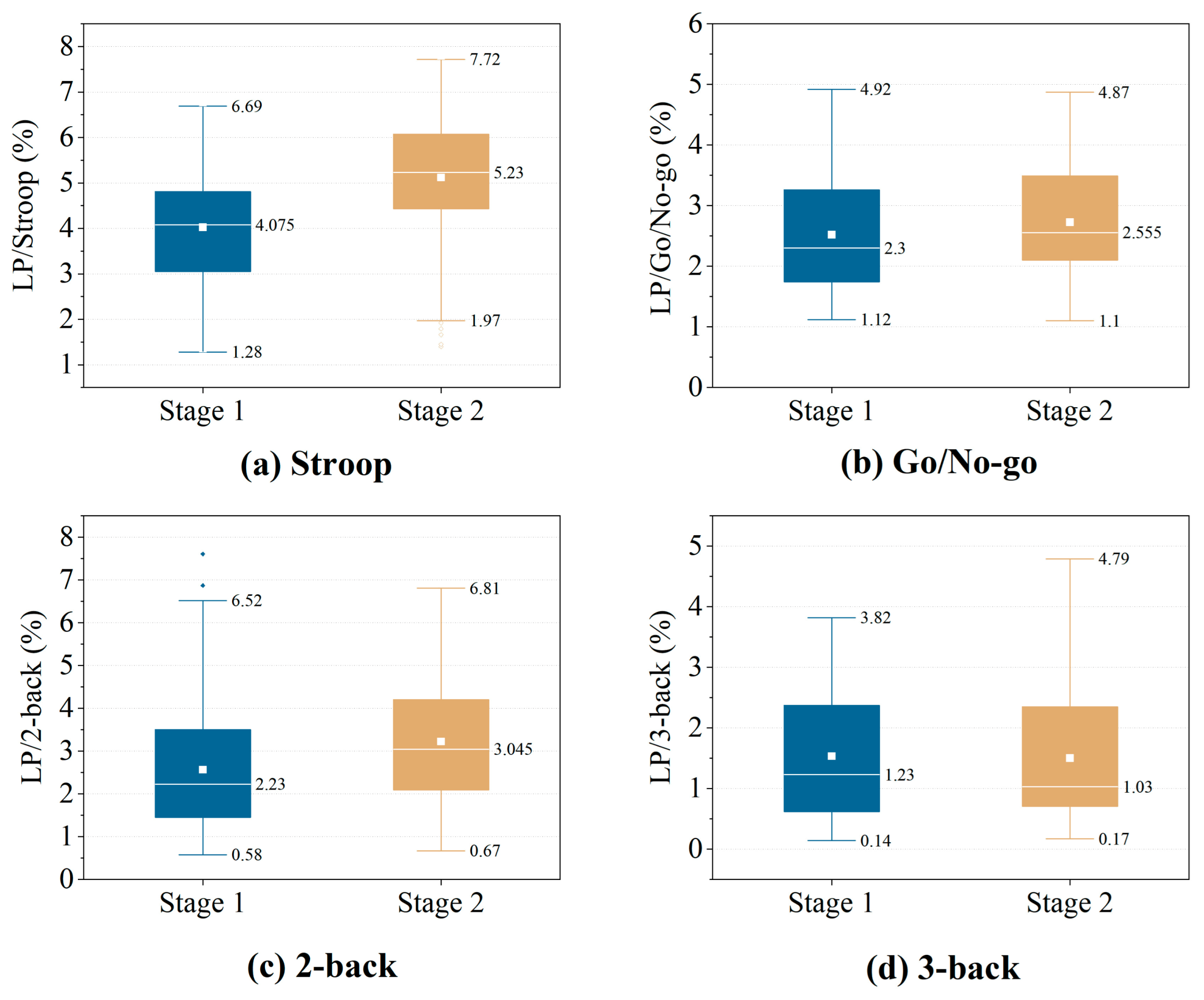
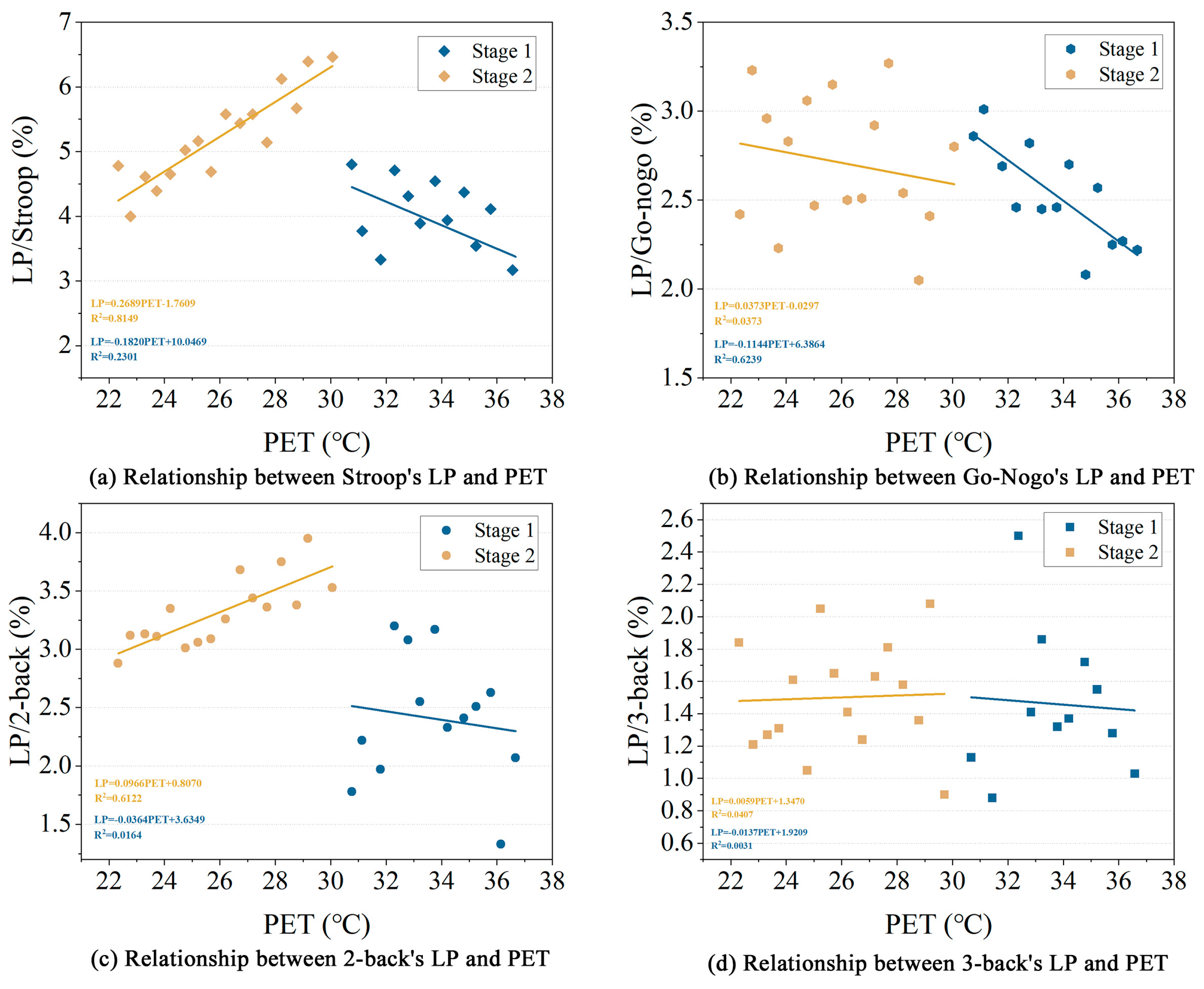
| Stage 1 | Stage 2 | |||||||
|---|---|---|---|---|---|---|---|---|
| Minimum | Maximum | Average | Standard Deviation | Minimum | Maximum | Average | Standard Deviation | |
| Air temperature, °C | 28.26 | 34.12 | 31.81 | 1.38 | 23.86 | 29.26 | 25.65 | 1.54 |
| Relative humidity, % | 60.3 | 88.8 | 71.92 | 0.46 | 52.4 | 72.4 | 59.81 | 5.69 |
| Globe temperature, °C | 28.22 | 34.72 | 32.1 | 1.47 | 24.19 | 31.69 | 27.51 | 1.6 |
| Wind speed, m/s | 0 | 1.64 | 0.4 | 0.46 | 0.02 | 2.31 | 0.64 | 0.45 |
| Mean radiation temperature, °C | 28.22 | 36.7 | 32.5 | 1.83 | 24.29 | 27.98 | 37.74 | 1.77 |
| PET, °C | 30.36 | 36.75 | 33.79 | 1.3 | 22.13 | 31.22 | 25.62 | 1.92 |
| Instrument | Type | Parameter | Measurement Range | Accuracy | Sampling Rate (s) |
|---|---|---|---|---|---|
| Thermal comfort level recorder | SSDZY-1 | Ta | −20.0–80.0 °C | ±0.3 °C | 60 |
| RH | 0.01–99.9% | ±2% (10–90%) | 60 | ||
| Tg | −20.0−80.0 °C | ±0.3 °C | 60 | ||
| Va | 0.05–5 m/s | 5% ± 0.05 m/s | 60 |
| Thermal Sensation | Thermal Comfort | Thermal Preference | Acceptability | Satisfaction |
|---|---|---|---|---|
| −3, Very cold | −1, Uncomfortable | −1, Cooler | −1, Unacceptable | −3, Very dissatisfied |
| −2, Cold | 0, Neutral | 0, No change | 1, Acceptable | −2, Dissatisfied |
| −1, Slightly cold | 1, Comfortable | +1, Warmer | −1, Slightly dissatisfied | |
| 0, Neutral | 0, Neutral | |||
| 1, Slightly hot | 1, Slightly satisfied | |||
| 2, Hot | 2, Satisfied | |||
| 3, Very hot | 3, Very Satisfied |
| Sex | Number | Age in Years (SD) | Height in m (SD) | Weight in kg (SD) | Body Surface Area in m2 (SD) | |
|---|---|---|---|---|---|---|
| Male | 219 | Mean | 21.57 (2.37) | 1.71 (0.0025) | 60.9 (37.96) | 1.67 (0.0062) |
| Maximum | 24 | 183 | 85 | 2.05 | ||
| Minimum | 18 | 160 | 50 | 1.46 | ||
| Female | 281 | Mean | 21.32 (3.58) | 1.58 (0.0035) | 51.89 (25.28) | 1.48 (0.0042) |
| Maximum | 24 | 1.67 | 65 | 1.70 | ||
| Minimum | 18 | 1.50 | 43 | 1.31 |
| Fatigue | Stage 1 | Stage 2 | |
|---|---|---|---|
| Total | 64.9 | 53.2 | |
| mental fatigue (%) | I feel impatient | 6.4 | 6.0 |
| I am uncertain | 19.3 | 12.4 | |
| I can’t concentrate | 23.3 | 13.9 | |
| Total | 49.0 | 32.3 | |
| drowsiness and dullness (%) | My eyes are getting tired | 34.2 | 25.9 |
| I can’t stop yawning | 15.4 | 10.4 | |
| I feel like lying down | 23.8 | 11.4 | |
| Total | 73.3 | 47.8 | |
| lack of physical integration (%) | I have a headache | 6.4 | 3.5 |
| My eyes are twitching | 8.4 | 2.5 | |
| My shoulder muscles are tense | 10.4 | 6.0 | |
| My limbs are shaking | 1.5 | 0.5 | |
| I feel unwell | 4.0 | 2.5 | |
| My back hurts | 4.0 | 2.5 | |
| I feel giddy | 1.0 | 1.0 | |
| Total | 35.7 | 18.4 | |
Disclaimer/Publisher’s Note: The statements, opinions and data contained in all publications are solely those of the individual author(s) and contributor(s) and not of MDPI and/or the editor(s). MDPI and/or the editor(s) disclaim responsibility for any injury to people or property resulting from any ideas, methods, instructions or products referred to in the content. |
© 2024 by the authors. Licensee MDPI, Basel, Switzerland. This article is an open access article distributed under the terms and conditions of the Creative Commons Attribution (CC BY) license (https://creativecommons.org/licenses/by/4.0/).
Share and Cite
Wang, W.; Zhao, Y.; Yang, J.; Du, M.; Luo, X.; Zhong, Z.; Huang, B. Influence of Thermal Environment on College Students’ Learning Performance in Hot Overhead Spaces in China. Buildings 2024, 14, 3225. https://doi.org/10.3390/buildings14103225
Wang W, Zhao Y, Yang J, Du M, Luo X, Zhong Z, Huang B. Influence of Thermal Environment on College Students’ Learning Performance in Hot Overhead Spaces in China. Buildings. 2024; 14(10):3225. https://doi.org/10.3390/buildings14103225
Chicago/Turabian StyleWang, Wanying, Yang Zhao, Jiahao Yang, Meng Du, Xinyi Luo, Ziyu Zhong, and Bixue Huang. 2024. "Influence of Thermal Environment on College Students’ Learning Performance in Hot Overhead Spaces in China" Buildings 14, no. 10: 3225. https://doi.org/10.3390/buildings14103225





